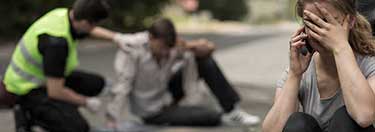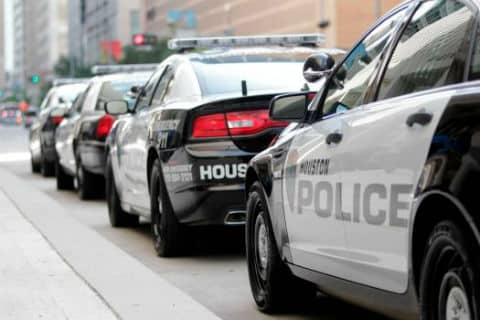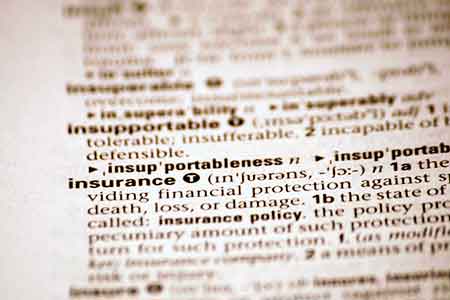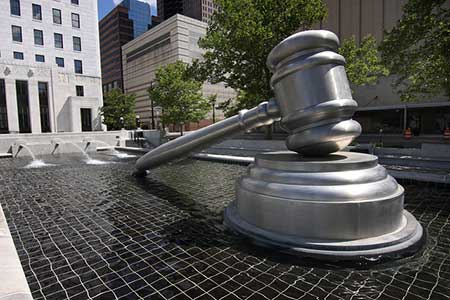How Car Accident Fault is Determined by Police, Insurance, and the Courts
In every car accident, someone will remain liable, also known as being at fault. Determining fault in a car accident involves identifying the negligent driver responsible for the crash. In most cases, it’s easy to determine which driver acted carelessly due to their behavior while driving. The negligent driver will be responsible for any injury, property damage, and even death that they have caused.
However, sometimes it can be difficult to tell who is at fault in an auto accident. Complicating things further is the fact that multiple entities might make a determination of fault after a car accident, including law enforcement agencies, insurance companies, and the courts.
This article will discuss how fault is determined after a car accident and where can you go for help after you’ve been injured in a wreck.
Car Accident Fault Questions Answered Here
Not ready to speak with a qualified car accident injury lawyer? Read on to gain a better understanding of your best course of action.
- How Does a Police Officer Determine Who Is at Fault in a Car Accident?
- How Do Insurance Companies Determine Who Is at Fault After an Auto Accident?
- How Does the Court Determine Who Is at Fault in a Car Accident?
- How can you tell who hit who in a car accident?
- Is the first party named in a police accident report at fault?
Not sure who’s at fault for your accident?
Submit the short form below to get a free case review.
How Police Determine Who Is at Fault in a Car Accident
Once a car accident is reported, police will come to the scene where they will fill out a police report of what happened. Police determine fault by analyzing the accident for physical evidence, talking to wintesses, and reviewing security footage that could have caught critical information.
The police officer will interview drivers, passengers, and any witnesses about the accident by asking a series of questions designed to piece together the sequence of events of the wreck. The goal is to piece together an account of what occurred.
Once the police officer decides that he or she has enough information, they will submit their report to their department.
The police report may contain a statement about who was at fault for the auto accident based on the police officer’s professional judgment. Typically, a police report will either establish fault based on the officer’s on-field report or provide information that will be critical in establishing fault. A police report can be a crucial tool in determining fault, but it doesn’t always assign an at-fault party. Unless a party specifically states that they caused the accident, a police report will not typically include blame. However, the report will have notes from the officer’s investigation that can be used to determine fault.
However, many police reports do NOT include a determination of fault. It’s important to understand that even if a police report states who was responsible for a car accident, this does not automatically mean that the person will be held legally responsible (or “liable”) for damages in a subsequent lawsuit. Police reports will not identify the at-fault party unless the driver admits fault. The report will, however indicate the details of the accident as gathered by the officer. This information can be critical in determining fault in an accident.
Texas is an at-fault state. In short, this means that whoever caused the accident can be held at least partially responsible for the damages. Evidence, photographs and video, are critical in establishing fault.
As part of a police officer’s investigation into a car accident, he or she may issue one or more traffic citations.
A traffic citation is a notice issued by a law enforcement officer that accuses a driver of violating a traffic law such as exceeding the speed limit or making an unlawful turn. It may indicate that a penalty such as a fine or deduction of points has been or will be assessed against the driver.
A traffic citation may also require a driver to appear in traffic court. While a traffic citation will not ultimately prove who is legally responsible for a car accident in a subsequent lawsuit, it may be used as evidence that the driver was negligent. This will be discussed in greater detail below.
How Insurance Companies Determine Who Is at Fault After a Car Accident
Following an accident, car accident victims will need to file a claim with their respective insurance company. Once a claim is filed with an insurance company, the company will assign an adjuster to the claim.
The adjuster oversees the investigation into the accident and the settlement of the claim. Typically, more than one adjuster will be involved during this process since each person that is in the wreck will need to file a claim.
In an investigation, adjusters will:
- Research the accident
- Speak with witnesses
- Look at medical reports
- Examine vehicle damage
- And verify details about insurance policies
Ultimately, adjusters will determine which driver was at fault. This includes sometimes assigning a percentage of fault to each driver. The insurance companies will apportion the costs of the car accident based on this percentage and will indemnify the drivers involved. Texas courts rely on a legal rule known as modified comparative negligence. Under this rule, you can typically recoup losses if you’re found to be less than 51% percent at fault for the accident.
Following your accident, acquire a copy of your crash report. Photographic evidence, video, and written statements about your accident will all be valuable assets in determining fault in relation to the accident.
Insurance companies will determine fault based on the legal definition of negligence in the state where the accident happened. An insurance adjuster will work to determine fault in a car accident. The adjuster will work to gather evidence, talk to witnesses, and determine the fault in the accident. A driver is determined to be negligent if they fail to exercise the amount of caution a reasonable person would under the same circumstances. For instance, a driver who runs a red light is seen as negligent compared to the reasonable driver who waits at a red light and drives at a green light.
How Courts Determine Who Is at Fault in a Car Accident
After a car accident, the victim may file a lawsuit to recover money for their injuries and damages. If you file a lawsuit following a car accident, the court will determine who was at fault by considering whether the defendant was negligent. As discussed above, a person is negligent when he or she fails to take reasonable caution under the circumstances.
In your case, a court will consider arguments from the parties’ lawyers, as well as various evidence presented by the lawyers. This includes testimonies from drivers, witnesses, police officers, and experts such as doctors and accident reconstructionists.
Either a judge or a jury, depending on who is responsible for deciding the case, will determine based on the evidence whether the other driver was negligent and must pay money to compensate for any injuries and other losses.
As stated earlier, it is important to understand that police reports and determinations of fault by insurance companies do not control the outcome of a court case. The rules of evidence may prevent certain evidence from being introduced during trial, including police reports, which are generally considered hearsay. Moreover, different rules govern the legal determination of responsibility for a car accident, including precedent from prior cases in the jurisdiction where your case is being heard.
Another thing to keep in mind is that evidence of a traffic violation, such as a traffic citation, may persuade the court that the party who committed the violation was acting negligently and is therefore at fault for the accident. This concept is known as negligence per se, and can be very helpful to your case if you were injured by a driver who violated traffic laws.
Evidence Involved in Determining Fault of a Car Accident
Obtaining a police report, gathering evidence, and speaking to witnesses are all fantastic ways to determine fault in a car accident. The sooner this information is gathered, the better to ensure information isn’t being lost to time. Whether you’re filing an insurance claim or a lawsuit resulting from a car accident, collecting evidence is crucial to determine the cause and its consequences. You need as much documentation as you can provide in support of your claim for injuries and other damages. Find out what kind of evidence is crucial to determining fault in a car accident and why they are important below.
Property Damage
Car damage, which may also be assessed by the police and insurer, is a major factor in determining fault. A vehicle’s rear may be damaged after the vehicle is rear-ended by the driver behind. In this case, it would be simpler to prove the driver behind is to blame. In any case, be sure to take pictures and videos of damaged vehicles following an accident. Evidence obtained in this manner is used later in making the determination of which driver was negligent.
Injuries
Images of your injuries are not the only thing you can use to determine who and why the accident happened. It is important to speak with a doctor who has handled accident cases in the past, as they may be able to shed light on the facts surrounding your accident. Those who are injured in accidents should get medical treatment as soon as possible. Regardless of whether you feel injured, seeing a doctor is a good idea. Many injuries aren’t immediately apparent, such as head injuries, or may manifest slowly, such as soft tissue injuries.
As soon as you see a medical professional, a doctor can take note of your injuries and the details of how your injuries occurred. In the future, these may serve as evidence. Moreover, if it is unclear who hit the other, a doctor may be able to provide testimony about how your injuries likely occurred.
Surveillance Footage
Public places are increasingly being monitored with surveillance cameras. Whether or not surveillance cameras are present at the site where an accident occurs is not within your control, but you should always check to see if the event was captured on the cameras. A video of the accident can be very helpful in determining fault.
Forensic Analysis
The evidence at the scene of a complicated accident, such as one involving more than one vehicle, may need to be evaluated by a forensic analyst. A forensic expert can examine photographic evidence, police reports, eyewitness accounts, and medical records to decipher the likely path and speed of the automobiles, where the impact occurred, and, if possible, who caused the collision.
Still Have Questions About Who Is at Fault After an Auto Accident?
A car accident is an overwhelming experience. Dealing with the police, insurance companies, and the possibility of a lawsuit can be difficult. If you have been injured in a car accident and you are concerned about whether or not you were at fault, our experienced car accident lawyers can help. In addition to providing valuable information and legal advice, our auto accident attorneys can help protect your rights and prevent your statements to the police and insurance companies from being used against you. Call 713-987-7111 to speak with a Sutliff & Stout accident lawyer today.
Frequently Asked Questions
What to do if someone sues you for a car accident in California?
If you find yourself out of state, like in California, and are involved in a car accident, the first step will be to contact your insurance provider. Communicating with them regarding how your policy works is key.
What happens if someone else is driving my car and gets in an accident in California?
Insurance companies will commonly either insure your vehicle or you specifically. If the former is the case, anyone driving your vehicle should be covered as the result of an accident. Before letting someone drive your car be sure to talk to the insurance company you use. Additionally, ask the person you place to allow to drive your vehicle if they have an insurance policy that covers them regardless of what vehicle they drive.
How to prove you are not at fault in a car accident?
The best to prove you are not at fault in-connection to a car accident is via evidence. One of the key pieces of evidence that will be available a few days after your crash is a police report. This document has valuable information that will help determine the vault in the accident.
What to do after a car accident is not your fault?
The first step following an accident, whether it is your fault or not, is to contact the police and your insurance provider. After leaving the scene of the accident safely, contacting your insurance provider should be priority number one.
If a car accident is your fault, what happens?
Since Texas is an at-fault state, you will be reqiured to be finacially responsible if you are found to be at fault for the accident. This will commonly mean that an insurance claim will be made against your insurance policy as the injured party seeks recovery for the associated damages.




